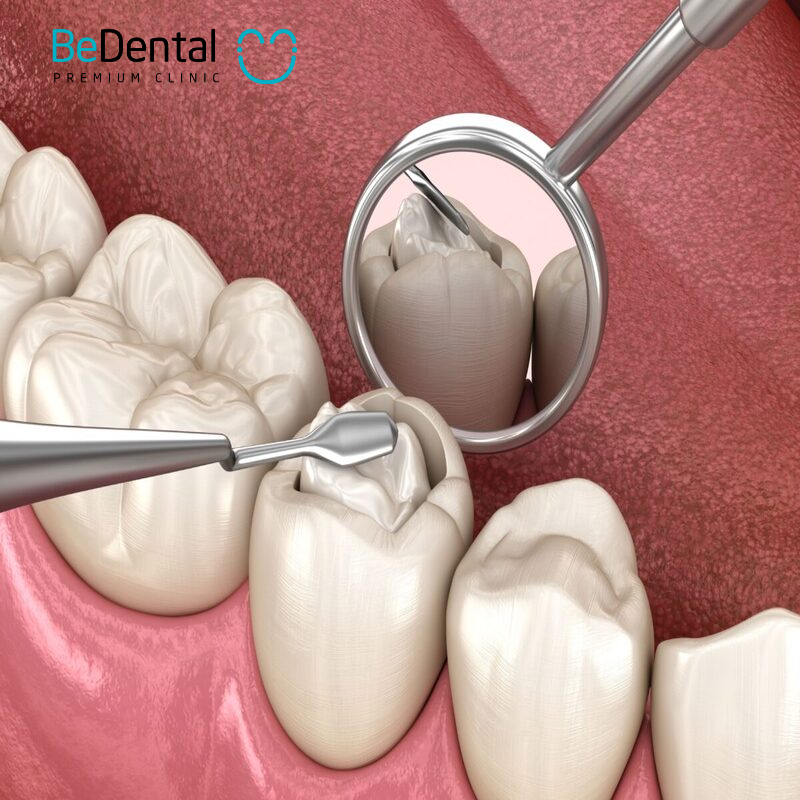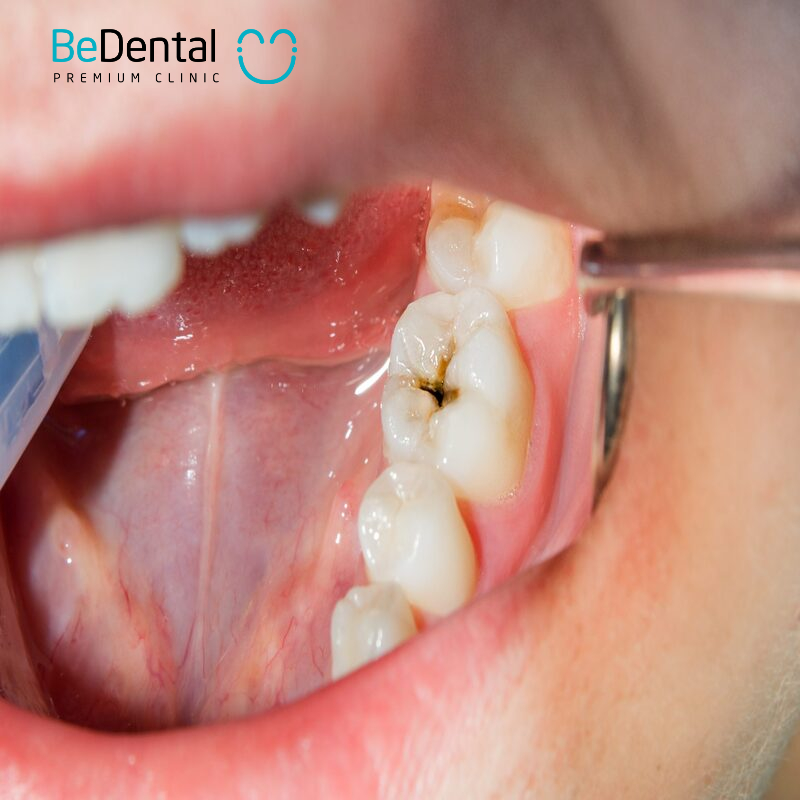What are dental fillings ? Dental fillings are among the most common dental treatments used to restore the function and aesthetics of damaged teeth. According to research by the World Health Organization (WHO), approximately 60-90% of children and nearly 100% of adults experience tooth decay to varying degrees. This highlights the growing demand for filling services. The American Dental Association (ADA) states that dental fillings not only prevent the progression of cavities but also protect teeth from further damage and improve chewing function.
When Do You Need a Dental Filling?
Certain situations indicate the need for a dental filling, including:
- Cavities: When a tooth decays, it forms a cavity that can cause pain and lead to infection if left untreated. Filling the cavity helps stop the decay from spreading.
- Chipped or Cracked Teeth: Trauma or strong impacts can result in chipped or broken teeth. Filling can restore the shape and function of the tooth, protecting it from further damage.
- Enamel Erosion: Enamel can wear down due to various factors, such as unhealthy eating habits or high-acid foods. A filling can help restore the tooth’s surface and protect the remaining enamel.
- Sensitive Teeth: If you experience discomfort when consuming hot or cold foods and beverages, filling can reduce sensitivity by filling gaps or eroded areas, creating a protective barrier for the tooth nerves.

What Are Dental Fillings? Types of Filling Materials
What are dental fillings? Dental fillings are used to restore the shape, function, and aesthetics of teeth that have been damaged by decay, chipping, or other issues. The filling process involves cleaning the affected area and using filling material to seal the cavity, helping to protect the tooth from further decay and restore its original shape.
Types of Filling Materials
Several filling materials are available, each with unique characteristics and applications. Here are some common types of fillings (types of dental fillings):
- Composite: Made from a blend of plastic and glass particles, composite fillings match the color of natural teeth, making them aesthetically pleasing. They are commonly used for visible teeth, such as incisors.
- Amalgam: This is a mixture of metals, including silver, copper, tin, and mercury. Amalgam fillings are durable and often used for molars where high strength is required. However, their darker color makes them unsuitable for front teeth.
- Ceramic: Ceramic fillings are strong and offer excellent aesthetics, making them ideal for cases requiring high cosmetic value. These fillings are often custom-made and suitable for visible teeth.
- Glass Ionomer: This cost-effective material is commonly used for small cavities. However, it is less durable than other materials and may discolor over time.
Depending on the condition of your teeth and your specific needs, your dentist will recommend the most appropriate filling material for you.
Benefits of Dental Fillings
Dental fillings not only restore the shape and function of teeth but also provide several other benefits:
- Preventing Further Decay: Fillings help halt the progression of cavities by sealing gaps and protecting teeth from bacteria and other harmful agents.
- Protecting Teeth from Additional Damage: By filling cavities, dental fillings safeguard teeth from further harm, minimizing the risk of more complex interventions in the future, such as root canals or extractions.
- Improving Chewing Function: Fillings restore normal chewing capability, allowing patients to eat comfortably without difficulty caused by tooth damage.
By promptly getting fillings, you can maintain your oral health and prevent more serious issues down the line.

Post-Filling Care
Proper oral care after receiving a dental filling is crucial for ensuring the effectiveness and longevity of the filling material. Here are some key points to keep in mind:
Maintain Good Oral Hygiene: Brush at least twice a day with a soft-bristled toothbrush and fluoride toothpaste. Floss daily to clean between teeth and remove plaque, helping to prevent cavities and gum disease.
Avoid Hard and Sticky Foods: In the days immediately following your filling, avoid eating hard or sticky foods that could affect the filling material or cause discomfort.
Limit Acidic Beverages: Stay away from acidic drinks such as soda, lemonade, and coffee for the first few days, as they can erode the filling material and increase sensitivity.
Monitor for Pain or Discomfort: If you experience prolonged pain or discomfort after your filling, contact your dentist for an evaluation, as adjustments may be needed.

Regular Dental Check-ups (Regular dental checkup): Regular visits to the dentist are essential for maintaining oral health, especially after receiving a filling:
- Evaluate Oral Condition: Routine check-ups help detect potential issues early, including new cavities, gum disease, or other irregularities.
- Maintain Filling Integrity: Your dentist will check the condition of the filling to ensure it remains intact and shows no signs of wear or damage. They may adjust or replace the filling if necessary.
- Tailored Care Guidance: Your dentist can provide specific advice on oral hygiene and dietary choices to maintain optimal oral health.
Proper oral care and regular check-ups will help you sustain the durability of your fillings and your overall oral health.
BeDental is a prominent brand for dental fillings in Vietnam
BeDental is a prominent brand for dental fillings in Vietnam. The clinic is known for providing high-quality dental filling services that effectively restore damaged teeth while ensuring patient comfort. With a team of skilled dental professionals, BeDental uses advanced materials and techniques to achieve durable and aesthetically pleasing results. The clinic prioritizes patient care and satisfaction, making it a trusted choice for dental filling services across the country.
At BeDental, the tooth filling process follows these key steps:
- Step 1-Examination and Diagnosis: The dentist conducts a thorough examination of your oral health to identify any cavities or issues that need addressing.
- Step 2-Treatment Planning: Based on the diagnosis, the dentist will discuss the recommended filling methods, material options, and associated costs with you.
- Step 3-Anesthesia: To ensure your comfort during the procedure, the dentist administers local anesthesia, so you won’t feel any pain.
- Step 4-Tooth Preparation: The dentist prepares the affected tooth by removing any decay and cleaning the area, making it ready for filling.
- Step 5-Filling the Tooth: The dentist fills the tooth with the chosen material, carefully ensuring it’s durable and aesthetically pleasing.
- Step 6-Check and Adjustment: After the filling is complete, the dentist checks the fit and comfort of the filling, making any necessary adjustments.
- Step 7-Care Instructions: Finally, you’ll receive guidance on post-filling care and any follow-up appointments that may be needed.
With increasing awareness of oral health and dental services, dental fillings have become a crucial part of everyone’s overall healthcare plan. Let’s explore the concept of dental fillings in detail and the situations where they are necessary to maintain the best possible oral health.
For those seeking further consultation regarding dental examination services, please visit BeDental’s locations in Hanoi or Ho Chi Minh City. You can also reach us at our hotline: (+84) 934.61.9090 / (+84) 899.555.636 or through our Facebook page, BeDental, for prompt and accurate assistance.




